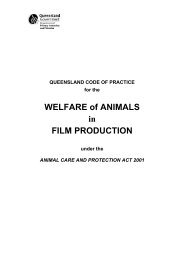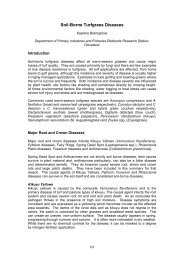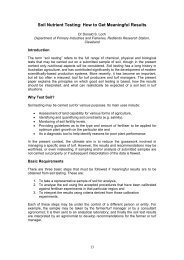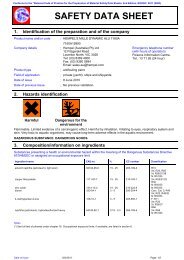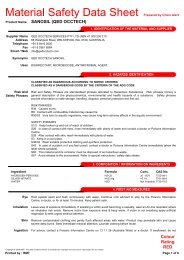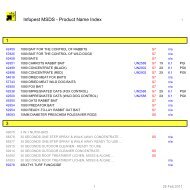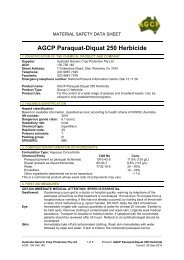You also want an ePaper? Increase the reach of your titles
YUMPU automatically turns print PDFs into web optimized ePapers that Google loves.
<strong>The</strong> <strong>Organic</strong><br />
<strong>Meat</strong> <strong>Myth</strong> <strong>revealed</strong><br />
Opportunities for New Zealand <strong>Organic</strong> beef and lamb in Europe<br />
By Angela Aitchison<br />
1998 <strong>Meat</strong> New Zealand – Link Foundation Fellow<br />
(previously the Waitangi Fellowship)<br />
Study date February 1999 to May 1999<br />
Publication Date June 1999<br />
1
What is the <strong>Meat</strong> New Zealand Waitangi Fellowship<br />
<strong>The</strong> Waitangi Fellowship was introduced as part of New Zealand’s celebration in<br />
1990 of the 150 th anniversary of the signing of the Treaty of Waitangi, the document<br />
that has been the basis of Maori/European relationships.<br />
<strong>The</strong> <strong>Meat</strong> New Zealand Waitangi Fellowship was established in 1991 to encourage a<br />
greater awareness and interchange between the wider meat trades of New Zealand<br />
and the United Kingdom.<br />
This scholarship provides an excellent opportunity for individuals to gain first hand<br />
experience in the meat industry and international trade issues.<br />
Acknowledgments<br />
Thank you to <strong>Meat</strong> New Zealand and the Waitangi Foundation for the opportunity to<br />
represent New Zealand as a Waitangi Fellow. To all the people throughout my<br />
travels who helped me access information, contacts, hosted me and arranged visits<br />
to organisations throughout the European Union.<br />
I hope that one day that I can return the hospitality and kindness. You have helped<br />
make my study tour unique and very rewarding.<br />
To be given the opportunity to study organic meat production and marketing was not<br />
only very personally rewarding, but it gave a signal to those who have committed<br />
their lives to organic meat production in New Zealand that the perseverance was all<br />
worth while.<br />
Thank you to the pioneers of the organic livestock industry. You have truly made a<br />
difference and I hope that in the future you can be rewarded for your efforts.<br />
Finially, a big thank you to the Southland Regional Council who has given me the<br />
time off from my employment to pursue this opportunity.<br />
2
Introduction<br />
I am from an organic livestock farming family in Central Otago New Zealand whom<br />
have been certified by Biogro New Zealand for the last 13 years. Currently I am a<br />
communications co-ordinator for the Southland Regional Council. Being able to<br />
combine on farm technical and commercial experiences with marketing, proved to be<br />
a valuable combination during this study.<br />
My investigations took me to Switzerland, Denmark, Sweden, Germany, Belgium, the<br />
Netherlands and the United Kingdom. I spent a total of six weeks on the continent<br />
and four weeks in the United Kingdom. During that time I met with producers,<br />
consumers, processors, importers, wholesalers, supermarkets, specialty stores,<br />
European officials, researchers and certifiers to get an overall appreciation of the<br />
organic meat industry.<br />
<strong>The</strong> views expressed in this report are my own and are not necessarily the opinions<br />
of <strong>Meat</strong> New Zealand or the Waitangi Foundation. I have made recommendations<br />
based off market signals, which I believe New Zealand should give serious<br />
consideration.<br />
Purpose of Project<br />
To investigate organic meat production, marketing and opportunities for New Zealand<br />
organic beef and lamb.<br />
Objectives<br />
• To shed light on the commercial viability of organic farming and the developing<br />
worldwide market trends.<br />
• To evaluate market opportunities for New Zealand organic beef and lamb.<br />
• To develop positioning statements of market advantage for New Zealand organic<br />
beef and lamb.<br />
• To understand the demographics and buying behaviour of target markets in the<br />
European union.<br />
• To assess research and development technology advances.<br />
3
Table of Contents<br />
Executive summary<br />
1.0 <strong>The</strong> mechanics of organics<br />
1.1 Revealing the myth<br />
1.2 What is organic meat<br />
1.3 Who are the certification agencies<br />
1.4 How do our standards compare<br />
1.5 Certification agencies that excel<br />
1.6 Issues with certification agencies<br />
2.0 Government Support<br />
2.1 Opportunity realised<br />
2.2 Playing the subsidy game<br />
2.3 European livestock standards not yet set<br />
2.4 Gaining third country importation status<br />
2.5 <strong>Organic</strong>s promotes regionality<br />
3.0 Growth in the organic sector<br />
3.1 Development by country<br />
3.2 <strong>Organic</strong> issues on the continent<br />
4.0 Livestock Production Technology<br />
5.0 Marketing<br />
5.1 Why people buy organic<br />
5.2 What are customer characteristics<br />
5.3 What methods of marketing are being used<br />
5.4 What types of meat products are being sold<br />
5.5 Instore marketing strategy<br />
5.6 <strong>The</strong> marketing mix<br />
5.7 Premiums<br />
5.8 Quality issues<br />
6.0 Starting an industry<br />
6.1 Where to from here<br />
6.2 <strong>The</strong> reality<br />
6.3 Does organic meat threaten other markets<br />
6.4 What are the challenges<br />
7.0 Positioning Statements for <strong>Organic</strong> beef and lamb<br />
8.0 Recommendations<br />
4
Executive Summary<br />
New Zealand has the opportunity to sell a very special organic story that connects<br />
producers with consumers.<br />
<strong>The</strong> organic industry is currently experiencing exponential growth. It is the fastest<br />
growing retail sector in the European Union.<br />
You can’t ignore the increasing numbers of organic products on the retail shelves.<br />
<strong>Organic</strong>s is not a fad; all major players are committed long term, but at present<br />
supply is unable to cope with demand. <strong>Organic</strong> food is no longer a niche market but<br />
a significant market sector.<br />
An opportunity exists to supply high quality organic chilled beef and lamb into the<br />
European Union under quota to specification in a complementary season.<br />
A window of opportunity exists for organic beef and lamb for approximately the next 3<br />
years at elevated premiums and beef for the next six years. Premiums are predicted<br />
to soften, as more products become available.<br />
Potential organic farmers are being wooed with attractive subsidy options.<br />
Many countries have ambitious organic production and consumption targets in place,<br />
but nobody can predict how quickly or by how much the market will grow.<br />
<strong>Organic</strong> meat like other organic products must commercially perform along side<br />
conventional. <strong>Organic</strong> meat is not a threat to conventional production, but a<br />
complementary alternative for those who demand choice. <strong>Organic</strong> is differentiated<br />
without damaging the conventional meats credibility.<br />
U.K supermarkets say that New Zealand lamb will always be their priority<br />
complementary season alternative after own country of origin.<br />
Value added organic meat products should be considered as the next market<br />
development.<br />
<strong>Organic</strong> production is not a get rich quick scheme. If premiums can be achieved they<br />
are often just a compensation for a loss in production.<br />
5
1.0 <strong>The</strong> Mechanics of <strong>Organic</strong>s<br />
1.1 Revealing the myth<br />
Misconceptions about organic production are rife and there are even more sceptics<br />
quick to criticise a production system they know little about.<br />
<strong>Organic</strong> production is simply producers working within their lands capabilities to keep<br />
animals and crops in peak condition. <strong>Organic</strong> farmers utilise science and technology<br />
to come up with preventative strategies instead of quick fix solutions.<br />
New Zealanders have taken longer to accept organic farming than our European<br />
counterparts. <strong>The</strong> stigma attached to people associated with organic farming in<br />
Europe has been almost been eliminated. Those involved are now respected and<br />
even viewed with some jealously.<br />
For many the organic conversion period is a conversion period of the mind.<br />
Meaning they have to radically change their farm management strategies.<br />
Certification agencies note that once a person has trialed organic production they<br />
find it is hard to go back to conventional farming.<br />
1.2 What is organic meat<br />
<strong>Organic</strong> meat is the product of an organic livestock system. It refers to the way an<br />
animal is reared, what foods it eats and what remedies are administered. Animal<br />
welfare issues and sustainable land management practices are all taken into account<br />
and audited by an approved certification agency.<br />
1.3 Who are the New Zealand certification agencies<br />
<strong>Organic</strong> production in New Zealand is certified by two main certification agencies, the<br />
Biological Producers and Consumers Council, (Bio-Gro), and the Biodynamic<br />
Farming and Gardening Association, (Demeter). Bio-Gro certifies biologically<br />
produced product, while Demeter certifies biodynamic product. Bio-Gro New<br />
Zealand has the largest number of registered growers. This trend is reflected<br />
worldwide with approximately 80% of producers farming biologically and 20% farming<br />
biodynamically.<br />
Bio-Gro New Zealand<br />
<strong>The</strong> Bio-Gro trademark is based on a set of standards for organic production and is<br />
recognised by IFOAM; (International Federation of <strong>Organic</strong> Agriculture Movement)<br />
based in Germany. Biological organic livestock farming is all about working within<br />
the lands capabilities and using preventative strategies to keep stock in the peak of<br />
health. Copies of the Bio-Gro New Zealand livestock production standards can be<br />
obtained from head office in Wellington.<br />
6
<strong>The</strong> Biodynamic Farming and Gardening Association<br />
<strong>The</strong> Demeter trademark is recognised by IFOAM and Demeter International.<br />
Biodynamic methods include most organic production practices, and in addition some<br />
specific techniques to enhance the living qualities of soil and plants. <strong>The</strong>se<br />
techniques stress the wholeness of nature, by treating all aspects of the farm and<br />
farm life as subtly inter-connected. A biodynamic farmer fine-tunes agriculture<br />
processes to harmonise with the natural rhythms of nature, including those of the<br />
stars and planets. Copies of the Demeter Standards can be obtained from the<br />
association based in Napier.<br />
1.4 How do our standards compare<br />
New Zealand organic livestock production standards are said to be one of the highest<br />
in the world. Climatic conditions, disease risks, environmental factors, legislation and<br />
laws make it hard to directly compare each countries organic standards.<br />
One international organic standard would be ideal but unrealistic. <strong>The</strong> problem is<br />
farming in Europe is quite different to the challenges of farming in New Zealand.<br />
Even within the European Union it has been difficult to establish a European wide<br />
livestock production standard. Until these standards are finalised, variations of<br />
livestock standards will continue to be a problem.<br />
Politics are playing an increasingly high profile in the organic movement. Certifiers,<br />
producers, the government and commercial enterprises are all competing for a piece<br />
of the action. <strong>The</strong>re has been some pressure to further reduce the livestock<br />
standards to encourage more to enter the industry, but the debate still rages in this<br />
area.<br />
New Zealand livestock standard will always have to be higher than our overseas<br />
competitors, but the question is how much better do we have to be Are we<br />
inhibiting a lucrative marketing opportunity because our standards are unrealistically<br />
high<br />
1.5 Certification agencies that excel<br />
Certification bodies in Europe are incredibly powerful and their brands are one of<br />
their biggest assets. For example the “KRAV” brand in Sweden is recognised by<br />
approximately 80% of the population. Both Sweden and Denmark are incredibly<br />
successful at marketing the benefits of organic farming to consumers and supporting<br />
their producers.<br />
<strong>The</strong>se same certification agencies genuinely support people in conversion and aim to<br />
provide their members with the appropriate tools to produce successfully.<br />
7
1.6 Issues with certification agencies<br />
<strong>The</strong> organic industry has grown so quickly that certification agencies are stretched to<br />
cope with the demand. For example the Soil and Health Association in the U.K has<br />
experienced an increase of 300% in the number of people wanting to convert since<br />
the beginning of 1999. Other certifiers have experienced the similar growth.<br />
Commercial companies reacting to market trends are finding it frustrating and very<br />
time consuming to deal with certification agencies. This frustration is mainly<br />
attributed to each organisation having different priorities. Certification agencies as a<br />
general rule are not commercially orientated organisations.<br />
Producers are having to wait for a conversion because of the backlog of work. Not<br />
only are certifiers under resourced, but also they often lack experienced staff who<br />
can deal with the variety of farming systems and industries they are asked to certify.<br />
Anybody considering certification should allow plenty of time to deal with the<br />
paperwork.<br />
2.0 Government Support<br />
2.1 Opportunity realised<br />
Governments actively support organic production because of the positive effect it<br />
having on their national economy and trade. Regional authorities view organic<br />
production as a more sustainable form of farming, which is deemed to be better for<br />
the environment.<br />
<strong>Organic</strong> production is also viewed as a way to reduce agricultural production and the<br />
number of imported organic products coming into Europe.<br />
Universities and Agricultural Institutions throughout Europe are receiving significant<br />
government funding for organic research and development.<br />
2.2 Playing the subsidy game<br />
Attractive subsides are available for producers in conversion, which is a great<br />
incentive to change. Some producers view organic production as a solution for<br />
marginal farming operation.<br />
Subsidises are supposed to be a compensation for a loss in production while<br />
producers are in conversion. New Zealand producers carry out this conversion<br />
period without any financial incentive, so the risk is so much greater.<br />
<strong>The</strong> U.K Grant Aid Scheme entitles producers in conversion to 450 pounds per<br />
hectare for 5 years. 50% in the first year and the rest spread over the next four. This<br />
has lifted the game and encouraged many people to convert with the lure of<br />
premiums at the end. If the five years of organic farming is not completed the money<br />
must be paid back to the government.<br />
8
European Farmers are concerned that subsidises will decrease and are looking<br />
towards New Zealands low cost production systems for answers. <strong>The</strong> justification for<br />
keeping subsidises is that they help to maintain landscapes and countryside values.<br />
2.3 European <strong>Organic</strong> Livestock standards yet to be set<br />
European Union legislation sets the rules for how products must be produced and<br />
processed to bear the word <strong>Organic</strong> or Bio. Products must bear the label of an<br />
approved certification agency for the consumer to be assured of its authenticity.<br />
European standards for crop and vegetable production are set but no organic<br />
livestock standards in place. <strong>The</strong>y are predicted to be in place within the next year.<br />
This means that each country develops its own certification standards.<br />
An organic lamb produced in Sweden may be produced to different standards than<br />
an organic lamb in Germany. A huge variety of standards exist between hundreds of<br />
certification agencies.<br />
Breakaway certification agencies have formed as the industry has grown to target<br />
particular groups, such as wine producers, horticulturalists or processing companies.<br />
2.4 Gaining Third Country Importation Status<br />
To ensure an exporting future for New Zealand organic products into Europe, we<br />
need to gain third country importation status. To attain this status an application<br />
proving New Zealand meets the all the EU legislative requirements in the organic<br />
arena must be presented to the European Commission in Brussels. <strong>The</strong>re is some<br />
urgency to complete this task as the deadline for completion is looming.<br />
<strong>The</strong> major challenge has been getting a competent authority, which has to be a<br />
government agency, to audit the New Zealand certifiers, BioGro New Zealand and<br />
Demeter. This is process is currently being assisted through OPEG, the <strong>Organic</strong><br />
Producers and Exporters Group in conjunction with MAF and the certification<br />
agencies.<br />
9
2.5 <strong>Organic</strong>s promotes regionality<br />
European meat purchasers will try to purchase country of origin products before they<br />
will buy externally. Up to 70% of organic products are imported, which is a sore point<br />
for many producers, especially when they don’t have their own marketing efforts coordinated<br />
and are potentially missing out on premiums.<br />
It is becoming trendy to specify where meat products come from in restaurants. It’s<br />
not just lamb, but Baverian lamb produced in the South of Germany.<br />
An argument exists that a product can’t be called organic if it has travelled half way<br />
around the world using non-renewable fossil fuels. This energy expenditure is<br />
referred to as food miles. Certification agencies actively promote this concept to<br />
consumers.<br />
Food miles are an artificial trade barrier and should be laid to rest with factual<br />
calculations of New Zealand v’s European energy expenditure from gate to plate. I<br />
expect the energy expenditure in producing an animal in Europe would outweigh the<br />
percieved benefit of buying locally.<br />
Although country of origin is actively promoted, the reality is that Europe can’t supply<br />
organic products year around in the qualities that are demanded.<br />
3.0 Growth in the organic sector<br />
3.1 Development of the Continent versus UK<br />
<strong>Organic</strong> farming was originally a vegetarian concept, and the development of organic<br />
products has followed similar lines. Initially sales begin with fresh fruit and<br />
vegetables, then cereals and dairy products. Typically meat products have only been<br />
introduced recently in any significant volumes. <strong>The</strong> continents organic meat market<br />
has developed more slowly than the U.K mostly because of poorly co-ordinated<br />
marketing efforts.<br />
European organic market development can be mainly attributed to cultural,<br />
environmental, health and animal welfare issues, while the U.K has been suddenly<br />
thrust into the organic culture via media debate over genetically modified foods, food<br />
safety and the previous B.S.E scare.<br />
Continental European markets are viewed as difficult to crack because of the<br />
extended distribution channels, language barriers and cultural differences, however<br />
just as much potential exists there as in the U.K.<br />
10
Lamb is not highly consumed meat on the continent, which is a hang over from post<br />
war mutton experiences. If organic lamb was introduced as a specialty product to<br />
people who eat organic, they are probably more willing to try something new than<br />
other consumers.<br />
3.2 <strong>Organic</strong> issues on the Continent<br />
In Europe livestock farming is often considered a waste of good food production land.<br />
This philosophy is a result of inefficiencies in livestock production and the pressure<br />
on space to produce.<br />
Specialty products such as salamis, sausages, pates, and meat spreads are well<br />
developed compared to chilled cuts of beef and lamb.<br />
<strong>Organic</strong> producers are finding the cost of production very high, which is reflected in<br />
the price of the meat. This means that the price of organic meat is often out the price<br />
range of the average householder and is mostly sold in high priced speciality stores.<br />
In the Netherlands, Flevoland has the highest number of organic producers. Whole<br />
areas are dedicated to organic production and if you choose to live in these organic<br />
zones then you must produce organically or derive business from organic products.<br />
Flevoland consists entirely of reclaimed land. It has been the Dutch peoples chance<br />
to have another go at looking after the environment and that is why there is such an<br />
emphasis on organic production.<br />
In Sweden farm incomes of equivalent organic and conventional farms have been<br />
compared and it is the organic farmers who are attaining better gross margins than<br />
conventional. It would be valuable to carry out this exercise in New Zealand, so<br />
those considering conversion get a realistic idea of what they are in for.<br />
European farmers believe organic meat production gives them more options. <strong>The</strong>y<br />
can sell their product as organic, integrated production or conventional depending on<br />
the market situation.<br />
Austria, Denmark and Sweden are exceptionally good selling the organic concept.<br />
<strong>The</strong>se countries lead the way for total amount of land under organic production.<br />
Denmark at a government level has developed a plan for action, which aims for<br />
100% of organic agricultural production. Although Germany was one of the first<br />
countries to promote organics it is one of the last to follow through with it.<br />
Europe has some quality and co-ordination issues for meat products and this<br />
provides the opportunity for New Zealand organic meat.<br />
11
In European organic livestock production they have a strong emphasis on welfare<br />
standards. <strong>The</strong>re are spacial arrangements which animals have to have. This is the<br />
organic farmers biggest production constraint, because land is so expensive and<br />
space to limited.<br />
4.0 Livestock Production Technology<br />
<strong>Organic</strong> livestock farming technology and methods, especially in the animal health<br />
area, were of limited use to New Zealand farming systems. This is due to the fact<br />
that producers are still allowed to use conventional health remedies with little impact<br />
on their organic status. Natural health remedies are not actively promoted because<br />
they are not licenced. Also with sheep production being on a very low scale on the<br />
continent there is not much incentive to put money into this area.<br />
A great deal of scientific research is going on into organic production which is of<br />
specific benefit to European farming systems, but are often not transferable to New<br />
Zealand certification standards or to our pasture feed livestock systems. ENOF,<br />
European Network of <strong>Organic</strong> Farming is an excellent initiative where research is<br />
funded by the EU and shared for the benefit of the whole industry.<br />
5.0 Marketing<br />
Europe has one thing we will never have and that is population and consumer power.<br />
Since organic food is showing such promising commercial opportunity the number of<br />
players in the industry are increasing all the time.<br />
<strong>Organic</strong>s is for growth, but what we don’t know is by how much, how quickly and for<br />
how long. Retailers are still testing the organic meat market and will continue to<br />
supply products for as long as their customers want them.<br />
At this early stage of organic meat industry it is hard to ascertain how many people<br />
eat organic meat. An emerging trend shows that those who do eat organic meat eat<br />
smaller portions than those that eat conventional.<br />
Although stories of great premiums are splattered over the pages of magazines,<br />
there is still a great deal of organic product sold conventionally throughout Europe.<br />
Being able to supply significant volumes consistently throughout the year is the main<br />
problem. Also producers in Europe don’t tend to be focused on producing to<br />
specification; as they are market takers rather than market makers.<br />
12
5.1 Why people buy organic<br />
<strong>The</strong> main reasons people choose to buy organic food are personal health concerns,<br />
pollution related illnesses, concern for the environment, animal welfare and ethical<br />
reasons along with taste and food safety. <strong>The</strong> week there is a health scare,<br />
instaneously the sales of organic product increase.<br />
For some people the main reasons for buying organic meat is the way an animal is<br />
raised. One company in Germany has set up an animal welfare friendly label to<br />
exploit this one specific marketing advantage, but acknowledge that in the future<br />
organic would take over.<br />
Perception plays a very important role in peoples purchasing decisions. <strong>Organic</strong><br />
means different things to different people. Lifestyle, income, circle of friends, fashion<br />
and stage of the life cycle influences organic food purchasing decisions.<br />
An increasing number of parents are buying organic food for their children, but not<br />
necessarily themselves. Parents concerned with food safety want to give their<br />
children the best start in life. Around 50% of the entire baby food market is now<br />
organic throughout Europe. In the future it will be interesting to see if those buying<br />
behaviours continue on as the child gets older and will that child as an adult buy<br />
organic product<br />
A number of people who eat organic food are vegetarian, but there is also a group<br />
that became vegetarian after the B.S.E scare who are now turning back to<br />
organically produced meat because they feel assured of its safety.<br />
Supermarkets expect clean production and increasing demands are being placed on<br />
suppliers to ensure production is environmentally sensitive, animal welfare friendly<br />
and safe. Dependence on artificial chemicals and fertilisers are being challenged.<br />
<strong>Meat</strong> will have to be “natural” or “organic”, there will be no other standards accepted.<br />
It will also have to be justified and backed up with proof. Additionally in the future to<br />
qualify for Farm Assurance programs in the U.K, meat willl have to be guaranteed<br />
free of transgenically modified organisms.<br />
5.2 What are organic customer characteristics<br />
<strong>The</strong> words “organic” and “biologic” are viewed as a brand and are highly valuable<br />
and recognised words European wide.<br />
<strong>Organic</strong> buyers are often grouped into the high disposable income category, but the<br />
rule doesn’t always apply. <strong>The</strong>re is also a number of people on lower incomes who<br />
buy organic because they believe in it. Never under estimate the power of the<br />
consumer to buy organic product for no other reason that it appeals to them at that<br />
particular point in time.<br />
13
Three main groups of people buy organic products that are dubbed greenies, foodies<br />
and feel goods.<br />
• Greenies - Those who buy organic products no matter what. <strong>The</strong>se people read<br />
labels, ask the tricky questions and believe in the whole organic concept.<br />
• Foodies - Those who are passionate about not just good food but great food and<br />
buy organic because they believe it tastes great.<br />
• Feel goods - Those that don’t necessarily buy organic products all the time, but<br />
will buy it as a treat when they have money left over at the end of the week.<br />
<strong>The</strong>se are the buy for the moment people.<br />
5.3 What methods of marketing are being used<br />
Farm shops<br />
Farm shop enterprises are very successful because they create an entertainment<br />
opportunity for the whole family. Consumers treat themselves to buying organic food<br />
produced on farm, with the additional bonus of seeing a farm in action and meeting<br />
the animals. Some Farm shops extend their product range by buying in products<br />
from off the farm. Farm shops work in Europe because they have a solid population<br />
base from which they can draw customers.<br />
Direct Marketing<br />
Direct marketing methods and box schemes are used successfully by many<br />
producers where orders are placed for meat and then delivered to customers doors.<br />
It is still one of the most common ways producers sell their products, however the<br />
balance is now shifting to more sophisticated retail outlets including butcherys, health<br />
food stores and supermarkets.<br />
<strong>The</strong> Internet is used as a tool to facilitate direct marketing efforts. <strong>Meat</strong> box schemes<br />
have also been set up to supply products to customers who forward order. Some<br />
schemes work through local health food stores where the customer can order a week<br />
ahead and pick up the product when they do their next shop.<br />
Co-operatives<br />
European distribution co-operatives began with organic enthusiasts rather than<br />
marketers. Many haven’t coped with the expansion of the industry and have been<br />
pushed out by conventional distribution companies who can use existing distribution<br />
channels and more efficient systems. Many of these co-operatives spend to much<br />
time organising small orders for low margins and high distribution costs.<br />
14
Co-operatives like BioFarm in Switzerland help market meat products on their<br />
producer’s behalf. <strong>The</strong>y have developed from a direct marketing customer base to<br />
now supplying larger retailers. Larger clients may push margins down, but the<br />
advantage is the company can forward plan significant volumes with their producer.<br />
Retail Outlets<br />
Specialist retailers such as health food stores were the first to stock organic products.<br />
<strong>The</strong>y still have highly committed regular clients who value product information and<br />
personalised informed service. However supermarkets have embraced the organic<br />
movement and are committing a huge amount of resources long term.<br />
A great deal of criticism exists about the multi-nationals move into this area, but the<br />
reality is they have given organic profile and helped mainstream organic products.<br />
Convenience and price still play a key role when people buy organic food. If organic<br />
products are to be main streamed then there needs to be a one-stop shop for<br />
purchasers.<br />
<strong>The</strong> U.K organic meat marketing arena has a higher level of sophistication than on<br />
the continent, but supermarkets have aggressively made inroads into this market.<br />
Supermarkets have their own label organic lines, which are distinguishable from<br />
conventional lines. <strong>The</strong>se products are easily recognised throughout the store and<br />
are profiled with point of sale marketing material. Sainsburies in the U.K was one of<br />
the best at this.<br />
It is believed that meat won’t form a large component of health food stores, as they<br />
are more vegetarian orientated.<br />
<strong>The</strong> inconsistency of personnel can pose a problem when trying to establish markets.<br />
Often the organic sections in supermarkets are handled by a number of different<br />
people who are frequently changed.<br />
Catering<br />
Gate Gourmets, (a division of the Swiss Air Group) organic airline food concept,<br />
Natural Gourmet, is helping them differentiate themselves in a highly competitive<br />
airline catering market. From surveys Swiss Air found that passengers wanted more<br />
natural food so they created the Natural Gourmet concept with the aim to be a<br />
market leader. Although airline food was not one of the top arguments for<br />
passengers wanting to fly a particular airline it may tip the balance for other airlines to<br />
use their service.<br />
Currently at least 50% of the food on the Natural Gourmet menu is organic or takes<br />
into account fair trade considerations. Tasty, nutrious food with excellent eye appeal<br />
is still of the upmost importance when designing inflight menus.<br />
15
An opportunity exists to supply this market but the challenge is to be able to supply<br />
cuts to very detailed specification. Gate Gourmet aims to buy very high quality, which<br />
they are finding hard to access. Most of their meat products are being sourced from<br />
South America.<br />
5.4 What types of meat products are being sold<br />
<strong>The</strong> opportunity for organic beef and lamb will mostly be a chilled market, because<br />
when people buy organic they perceive it to be a fresh product. Long term there is<br />
an opportunity for frozen and further processed frozen meat, but in the mean time<br />
most who buy in the freezer cabinet are budget buyers.<br />
As in conventional meat marketing the challenge is selling the whole carcasses. You<br />
have the same problems selling organic lamb flaps as you do conventional ones.<br />
<strong>The</strong> higher priced cuts have to compensate for the lower priced cuts, to attain an<br />
overall premium.<br />
Unlike specialist butchery shops, supermarkets pack off site and don’t have the<br />
facilities to repack if a product doesn’t sell by the use by date. Some stores have a<br />
higher wastage percentage for organic meat because they haven’t structured the<br />
price according to their stores customer base.<br />
Opportunities exist for both lamb and beef, although it is difficult with quota<br />
allocations to get beef into Europe. Companies should seriously consider supplying<br />
organic beef at higher premiums than lamb demands. It takes longer to finish beef<br />
so therefore longer to saturate the market compared to lamb.<br />
With a good lamb quota allocation it shouldn’t be difficult tapping into the lamb<br />
market. <strong>The</strong> difficulty is predicting how long it will stay at the current premiums.<br />
5.5 In store market strategy<br />
In Switzerland, Migros, one of the two major supermarket chains has created their<br />
own organic certification standards. <strong>The</strong>y also market an integrated production line<br />
alongside their organic lines. <strong>The</strong> labelling of each of the lines are very similar and if<br />
buyers aren’t careful they could think they were buying organic when they are not.<br />
U.K, Danish and Swedish Supermarkets label and market their organic products very<br />
well, while other European supermarkets hadn’t clearly located products in store.<br />
Germany with its 59 certification agencies with different logos created confusion<br />
unless you know what you’re looking for.<br />
16
A market strategy engaged by many supermarkets for profiling organic products was<br />
to create an area in the store with an example of all the organic products stocked and<br />
then double place them along side the conventional products.<br />
<strong>Organic</strong> products do sell well but they don’t sell themselves. <strong>The</strong>re still has to be an<br />
excellent marketing and promotional effort to support the product. Often retailers will<br />
subsidise product into the store to get it established. Retailers in Europe don’t<br />
feature meat as highly as the United Kingdom.<br />
Packaging of organic products no longer has that recycled look, but are colourful and<br />
use conventional types of packaging. Certification agencies promote recyclable,<br />
reduceable or reuseable packaging. Packaging and presentation of meat must<br />
emphasise the freshness and the wholesome taste appeal.<br />
<strong>Meat</strong> must be viewed as a food not meat and must look highly attractive and<br />
unrelated to its animal origin in the chiller. If organic meat is to move into the freezer<br />
cabinet the challenge is to make it look more attractive.<br />
<strong>Organic</strong> meat may not appear in every supermarket store, as outlets are selected on<br />
the demographic group the store is trying to attract.<br />
5.6 <strong>The</strong> marketing mix<br />
Price, packaging, volumes, product appeal and location on the shelf all play a big role<br />
in purchasing decisions. To a limited few price plays no role at all, but to the majority<br />
of consumers price is the biggest contributing factor to why people buy or don’t buy<br />
organic meat.<br />
Retailers find that up to a point a consumer will tolerate a premium but after that<br />
sales drastically fall off. Success of organic meat sales depends on meat being<br />
given good profile on the shelf.<br />
Retailers want to be assured that meat can be supplied consistently throughout the<br />
year otherwise they won’t commit to it. That is why only small lines of meat are<br />
available in the chiller. One sure way to turn customers away is to not have product<br />
available when they expect it to be there.<br />
One way processors have tackled the price differential, is by packaging product in<br />
smaller quantities to keep the perceived unit price down. In Europe meat is sold per<br />
hundred grams rather than per kilogram, which also helps to make the price appear<br />
more compariable.<br />
17
When marketing an organic product, emphasise the word organic or Bio because<br />
those are the things that consumers look for. Also be wary of the labelling<br />
regulations for organic products, it can be difficult to get this right.<br />
Location of the retail outlet is critical. Research shows that most consumers will only<br />
travel within a five-mile radius of their home to purchase food.<br />
Health Food stores create customer loyalty by keepings their customers informed.<br />
<strong>The</strong>y help people buy into a concept, a story, a process and a belief. On the<br />
continent sales of organic products are orientated more towards health food stores<br />
than supermarkets, while in the United Kingdom it is exactly the opposite.<br />
Specialty high value shops have a real place with organics. <strong>The</strong>y target the true food<br />
lovers with the higher disposable income. Full shops are not completed here, its<br />
more about feeling good, buying for self-gratification and to be seen with the bag<br />
walking out of the shop.<br />
In Europe Sunday window-shopping is very important, and retailers will dress their<br />
windows especially for that day to attract sales for that week. Weekends are<br />
everything and are key marketing times.<br />
5.7 Premiums<br />
Price plays the largest role in people’s organic meat purchasing decisions because it<br />
is a high cost item in the shopping trolley each week. Health food shops are able to<br />
demand a higher premium because of the type of customers they attract, but<br />
supermarkets in there attempt to convert the unconverted find that price is the<br />
biggest sticking factor.<br />
Surveys completed by individual supermarkets find that consumers would prefer to<br />
buy organic products if they had the choice, but often price makes them change their<br />
mind once they enter the store.<br />
<strong>The</strong> amount spent per week by a family buying organic and a family buying<br />
conventional has been compared. <strong>The</strong>re was hardly a difference because the<br />
organic shopper buys less processed foods and smaller amounts of higher priced<br />
commodities such as meat and dairy products.<br />
Premiums for organic meat vary from country to country, retailer to retailer and<br />
producer to producer and depend on product availability and rearing difficulties. Beef<br />
can demand a premium of up to 100% because of the time it takes to produce an<br />
animal, a lamb between 20-40% and Pork and Chicken up to 200-300%. <strong>The</strong>se<br />
18
premiums are supposed to reflect the difficulties in producing these animals<br />
organically.<br />
Premiums have softened on the continent and are beginning to mirror conventional<br />
prices. Conventional prices for many meat products are at an all time low. <strong>The</strong><br />
concern is that conventional prices will recover, but organic might not move in<br />
proportion, therefore reducing the incentive to farm that way.<br />
5.8 Quality issues<br />
<strong>The</strong> professionalism of organic product has rapidly improved. It no longer has that<br />
hippy product image, but is highly commercial. <strong>Organic</strong> meat is expected to be of the<br />
same or even higher standard than conventional. If people are paying a premium for<br />
their meat they expect a high degree of product integrity.<br />
At present a greater specification range for beef and lamb is being tolerated, but that<br />
will change when supply starts to reach demand. Once buyers have a choice of<br />
suppliers they will be able to push the premiums down.<br />
Quality assurance programs, traceability, along with organic certification are<br />
demanded by all the major retailers. Customers who buy organic really do want to<br />
know where the product comes from and who produces it. <strong>Organic</strong> production brings<br />
producers and consumers back into old-fashioned food relationships built on trust<br />
and quality.<br />
6.0 Starting an industry<br />
6.1 Where to from here<br />
Marketing organic meat has the same challenges as conventional and that is why it’s<br />
only until now that it has really started to develop. One of the only ways to feasibly<br />
set up an industry to consistently supply European markets is to for organic livestock<br />
producers to form partnerships with processing companies.<br />
New Zealand has to work on getting enough farmers to produce the volumes that are<br />
required year around. Those producers who are already in the industry or in<br />
conversion now are the primary target group. Those interested in converting need to<br />
be encouraged also but it will be at least three years before they come on line.<br />
Processing companies can attain organic certification of their plants and use existing<br />
distribution channels, quota allocations and licences to supply markets. However in<br />
this fledging industry it is important to emphasise the word partnership. It is<br />
important that both producer and processor understand and respect each other’s<br />
areas of expertise.<br />
19
It is important that organic meat marketing is approached strategically and that<br />
companies don’t complete fruitlessly to fragment the market or flood it. Prices must<br />
be maintained at a level realistic for organic farmers to produce economically. Clear<br />
signals must be given to farmers about realistic premiums and production<br />
requirements for next season, because it is harder to switch quickly in an organic<br />
system.<br />
Individuals will find it costly to buy quota, attain licence and transport small volumes,<br />
however the advantage of this is you maintain control of the marketing effort. This<br />
type of marketing may suit exporters supplying specialised outlets on the continent.<br />
6.2 <strong>The</strong> Reality<br />
<strong>Organic</strong> farming is not a get rich quick scheme. It is not for the faint hearted with up<br />
to three years of transition to become a fully certified organic producer and incurring<br />
a loss in production over this time.<br />
If you can gain a premiums for organic meat it is often just a compensation for a loss<br />
in production. Premiums are not guaranteed. However if you are prepared to enter<br />
into this farming system long term you can be rewarded in supplying an increasingly<br />
demanded product. Market chasers beware.<br />
6.3 Does organic meat threaten other markets<br />
<strong>The</strong> only threat that organic farming poses to conventional, is that it challenges the<br />
way conventional farmers think. <strong>Meat</strong> producers of New Zealand have been<br />
sceptical that organic product will jeopardise the marketing of New Zealand natural<br />
lamb and beef, but all major retailers tell a different story. <strong>Organic</strong> meat is<br />
differentiated without discounting conventional. Let’s face it over 95% of retailers<br />
business is still conventional foods, so they are not going to jeopardise that.<br />
6.4 What are the Challenges<br />
<strong>The</strong> challenge is to make organic profitable using the quantities available with our<br />
distance from the market. Europe is also incredibly regulated and it is difficult to<br />
negotiate distribution channels. You can’t load extra costs of production and<br />
distribution on the meat otherwise the prime cuts become unmarketable.<br />
Supermarkets set the trends, not producers and consumers. Our distance from the<br />
market makes producers complacent and often immune the urgency required to<br />
respond to changing market needs.<br />
20
One of the biggest dangers for the organic industry at this fragile point would be a<br />
media scare that tries to undermine the industry. Although the media has been one<br />
of the greatest assets to the industry it could also be its greatest downfall.<br />
7.0 Positioning Statements for organic beef and lamb<br />
New Zealand has<br />
• an ideal climate and farming system for organic production.<br />
• a broad genetic base of animals exist that be selected for to cope with<br />
organic farming systems.<br />
• the infrastructure and ability to process organic meat already exists.<br />
• producers are experienced in producing to specification and to high<br />
quality standards.<br />
• an excellent reputation and a story, which organic meat can built off.<br />
• geographical isolation from pests and diseases, is nuclear free with the<br />
potential to be G.M.O free.<br />
• an excellent food safety record.<br />
• organic meat can be produced highly competitively<br />
• certification agencies to inspect product<br />
• markets already available to tap into<br />
8.0 Recommendations<br />
New Zealand’s biggest marketing opportunity is to be a country free from<br />
transgenically modified organisms. Consumers Europe wide have been very critical<br />
of the way that modified products have been introduced through the backdoor. Many<br />
of the major supermarkets in the U.K have formed consortiums to purchase nongenetically<br />
modified product. This is one of the first times supermarkets have taken a<br />
complete turn to satisfy customers.<br />
<strong>The</strong>re is a greater need for research and development into organic farming<br />
techniques if New Zealand is to set up a sustainable industry. An organic MRDC<br />
monitor farm would be a real benefit to the industry and comparative analysis of<br />
21
gross margins of organic v’s conventional farms. <strong>The</strong> only way to prove the<br />
credibility of the industry is to prove organic production methods with science.<br />
National and International research needs to be co-ordinated to form a New Zealand<br />
organic handbook or quide book of how to get started in organic. At present it is just<br />
trial and era.<br />
New Zealand exporters should seriously consider being part of the year 2000<br />
BioFach and U.K Natural and <strong>Organic</strong> Foods trade fairs. Many other countries have<br />
got together to form a country of origin pavilion. <strong>The</strong>se are flagship trade shows with<br />
plenty of opportunity.<br />
New Zealand doesn’t want to be pushed into a position of being a raw commodity<br />
trader, it needs to be an innovator to ensure the future of the industry. Value added<br />
opportunities should be pursued now before the market becomes flooded.<br />
<strong>The</strong> myths of organics need to be <strong>revealed</strong> and the community educated about what<br />
organic production is about. Not just producers but also consumers.<br />
22






